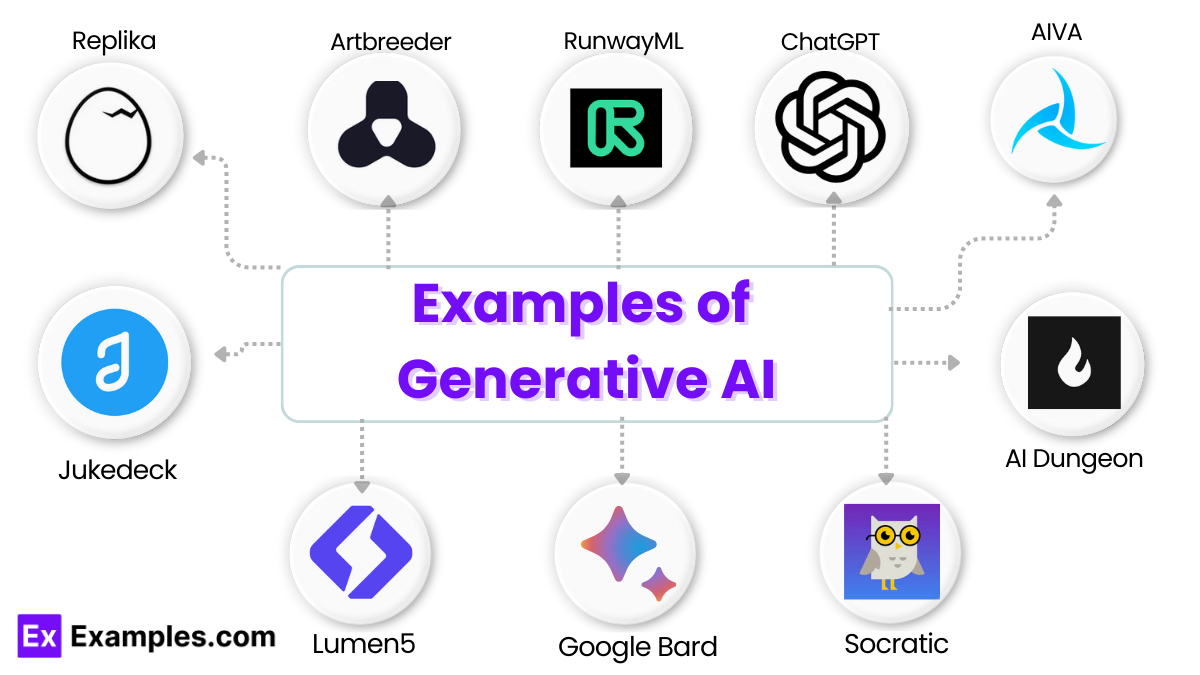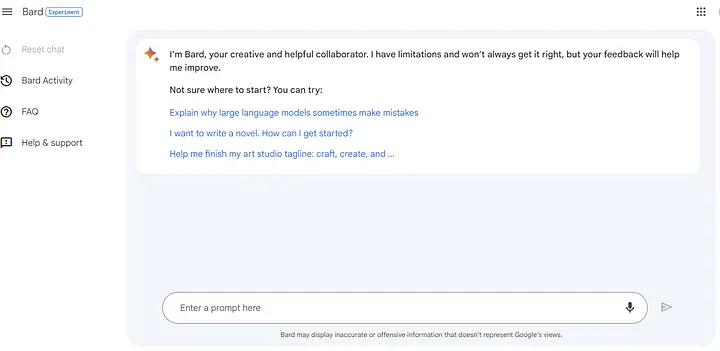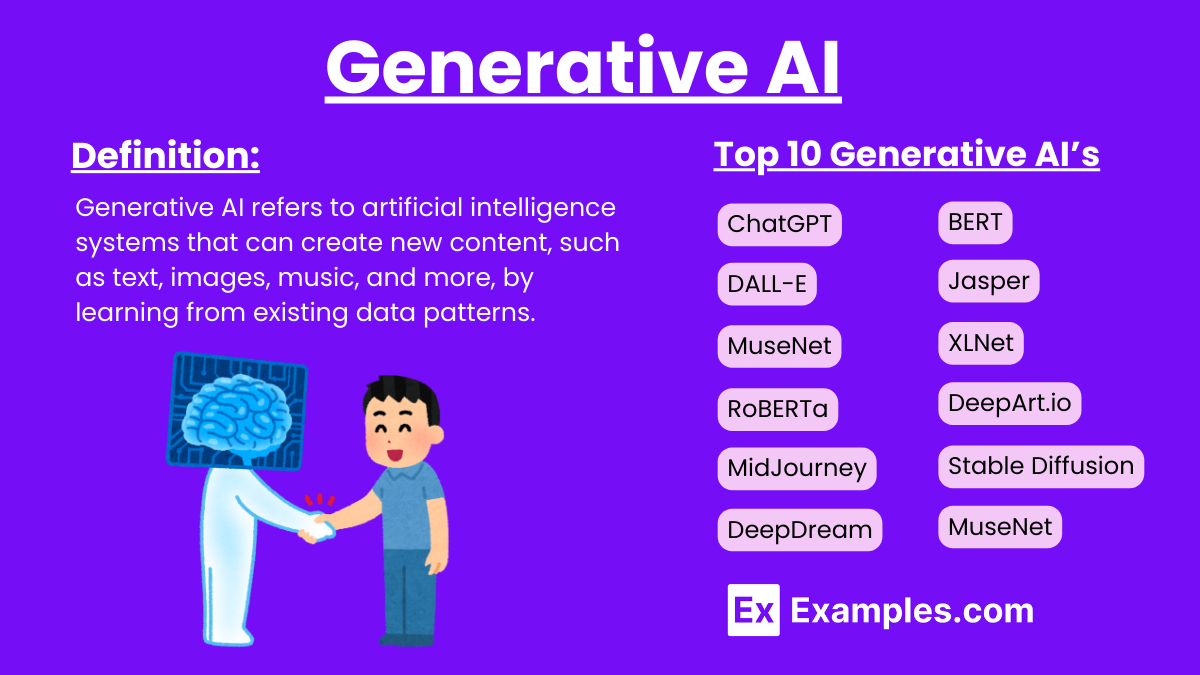10 Generative AI Examples
Generative AI refers to algorithms, such as neural networks, that can create new content, from text and images to music and beyond, by learning from existing data. In business, it revolutionizes product development and customer experiences. Payment systems leverage generative AI for fraud detection and personalized financial services. In marketing, it enables hyper-personalized content, automating ad creation, and optimizing campaign strategies. This technology is transforming industries by enhancing efficiency and innovation.
What is Generative AI?
Generative AI is a type of artificial intelligence that can create new content, such as text, images, and music, by learning patterns from existing data. It uses advanced algorithms, like neural networks, to generate outputs that resemble human-created content. This technology is widely used in various fields, including art, entertainment, and business.
Examples of Generative AI

ChatGPT: A language model that can generate human-like text based on prompts, useful for customer support and content creation.

DALL-E: An AI that creates images from textual descriptions, revolutionizing design and creative industries.

Google Bard(Gemini): Google Bard Gemini is an advanced AI model developed by Google, designed to generate creative and coherent text based on user prompts. It leverages deep learning techniques to produce high-quality writing in various styles and formats, from poetry to technical writing.

RunwayML: A platform that offers tools for generating high-quality video content, aiding filmmakers and content creators.

Artbreeder: An AI tool that combines and evolves images to create unique art pieces.

Replika: An AI chatbot designed to simulate conversations with a human, providing companionship and support.

Lumen5: An AI-powered video creation platform that transforms articles into engaging videos for social media and marketing.

Jasper: Jasper is a generative AI model tailored for content creation, including blog posts, social media content, and marketing copy. It leverages GPT-3 technology to assist writers in generating high-quality, engaging content.

Bing Chat: Bing Chat, developed by Microsoft, is an AI-powered conversational tool integrated with the Bing search engine. It provides users with quick, interactive answers and personalized assistance through natural language processing.

Rytr: Rytr is an AI-powered writing assistant designed to assist users in generating various types of content, including blog posts, social media updates, marketing copy, and more. It utilizes sophisticated algorithms to produce engaging and contextually relevant text based on user input.

Anyword: Anyword is an AI-driven platform that assists users in generating effective marketing copy for advertisements, emails, social media posts, landing pages, and more. By utilizing data-driven insights and predictive performance scoring, Anyword ensures that the generated text resonates with the target audience and achieves the desired impact.

Applications of generative AI
Marketing
- Content Creation: Generating personalized marketing content, including emails, blog posts, and social media updates.
- Ad Optimization: Creating and testing multiple ad variations to identify the most effective campaigns.
- Market Research: Analyzing trends and consumer behavior to generate insightful reports.
Payment Systems
- Fraud Detection: Identifying and preventing fraudulent transactions through pattern recognition and anomaly detection.
- Personalized Financial Services: Offering tailored financial advice and services based on user data.
- Automated Transactions: Streamlining payment processes using AI-generated algorithms.
Entertainment
- Content Generation: Producing movies, music, and games with AI-generated scripts, compositions, and designs.
- Interactive Experiences: Creating immersive virtual worlds and interactive storytelling experiences.
Healthcare
- Medical Imaging: Enhancing and analyzing medical images for better diagnosis and treatment plans.
- Drug Discovery: Generating new chemical compounds for pharmaceuticals.
Education
- Tutoring Systems: Providing personalized learning experiences and generating educational content.
- Language Translation: Offering real-time translation and language learning tools.
Art and Design
- Graphic Design: Assisting artists in creating unique artwork and designs.
- Fashion: Designing new clothing lines and styles using AI-generated concepts.
Real Estate
- Property Listings: Automatically generating detailed property descriptions and marketing materials.
- Virtual Staging: Creating virtual furnishings and decor for property visualizations.
Legal
- Document Review: Automating the review and generation of legal documents.
- Contract Analysis: Analyzing and generating contract terms and conditions.
Human Resources
- Recruitment: Screening and generating job descriptions, as well as predicting candidate success.
How to find solutions with generative AI
Define the Problem Clearly:
Be Specific: Clearly state what you need help with. A well-defined problem is easier to solve.
Example: Instead of asking, “How can I improve my website?”, specify, “How can I increase user engagement on my e-commerce website?”
Choose the Right AI Tool:
Select Appropriate AI: Use a generative AI model suited for your task. ChatGPT is great for text-based tasks, while DALL-E is suitable for image generation.
Input Clear and Detailed Prompts:
Be Detailed: Provide as much relevant information as possible in your prompt.
Example: “Generate a list of 10 strategies to increase user engagement on an e-commerce website focused on selling handmade crafts.”
Use Iterative Refinement:
Iterate and Refine: If the first output isn’t perfect, refine your prompt and try again.
Example: If the initial strategies are too generic, refine the prompt: “Generate a list of 10 detailed strategies to increase user engagement on an e-commerce website that sells handmade crafts, focusing on social media integration and user-generated content.”
Evaluate and Implement Solutions:
Critically Assess Output: Review the AI-generated solutions critically. Select and implement the most relevant and feasible ones.
Example: If the AI suggests creating a social media challenge, evaluate if it aligns with your brand and resources.
Examples of Using Generative AI to Find Solutions
Example 1: Content Creation
Problem: Need blog post ideas for a travel website.
Prompt: “Generate 10 unique blog post ideas for a travel website focusing on budget travel tips.”
AI Output:
Example 2: Product Development
Problem: Need new product ideas for an eco-friendly brand.
Prompt: “Suggest 5 innovative product ideas for an eco-friendly brand targeting millennials.”
AI Output:
Example 3: Marketing Strategies
Problem: Increase social media engagement for a fitness app.
Prompt: “Generate 5 social media engagement strategies for a fitness app targeting young adults.”
AI Output:
Types of Artificial Intelligence
Narrow AI (Weak AI)
Narrow AI, also known as Weak AI, is designed to perform specific tasks. It operates within a limited context and cannot generalize its knowledge to other domains. Examples include virtual assistants like Siri and Alexa, image recognition systems, and recommendation algorithms used by streaming services.
General AI (Strong AI)
General AI, also known as Strong AI, refers to AI systems with the ability to understand, learn, and apply knowledge across a wide range of tasks at a level comparable to human intelligence. This type of AI remains theoretical and has not yet been realized. It would have the capability to perform any intellectual task that a human can do.
Superintelligent AI
Superintelligent AI is a hypothetical form of AI that surpasses human intelligence in all aspects, including creativity, problem-solving, and emotional understanding. This type of AI would be able to perform tasks and solve problems that are beyond human capabilities. The development of superintelligent AI raises significant ethical and existential questions.
Weak AI (Narrow AI) vs. Strong AI (General AI)
| Aspect | Weak AI (Narrow AI) | Strong AI (General AI) |
|---|---|---|
| Definition | AI designed for specific tasks or applications | AI with the ability to perform any intellectual task that a human can |
| Scope | Limited to predefined functions | Broad, with the potential to understand, learn, and apply knowledge across various domains |
| Example | Virtual assistants like Siri, image recognition systems | Hypothetical future AI with human-like cognitive abilities |
| Current Status | Widely implemented and used in various industries | Not yet achieved; remains a theoretical concept |
| Learning Ability | Learns within a narrow domain using specific data and algorithms | Capable of learning and adapting across multiple domains autonomously |
| Adaptability | Highly specialized, limited adaptability outside its designed task | Highly adaptable, capable of handling new and unforeseen tasks |
| Complexity | Less complex, easier to develop and control | Extremely complex, poses significant development and control challenges |
| Real-World Impact | Currently drives many practical AI applications | Potential to revolutionize all aspects of human life and industry |
Tips for Effective Use of Generative AI
- Be Clear and Concise: Clear and concise prompts yield better results.
- Use Contextual Information: Provide context to guide the AI.
- Be Open to Iteration: AI outputs might need refining; iterate as necessary.
- Combine AI with Human Insight: Use AI-generated solutions as a starting point and refine them with your expertise.
- Stay Updated: AI models improve over time. Stay updated with the latest features and capabilities.
What is generative AI?
Generative AI creates new content, such as text, images, and music, by learning patterns from existing data.
How does it work?
It uses machine learning models, especially neural networks, to generate data similar to its training inputs.
What are common applications?
Applications include chatbots, content creation, image generation, and code writing.
What are its limitations?
Generative AI can produce inaccurate or biased results and may require human oversight.
How can businesses benefit?
Businesses can automate content creation, enhance customer service, and innovate product development with generative AI.
Is generative AI secure?
Security depends on the implementation and usage, but risks include generating harmful or misleading content.
How is generative AI trained?
It is trained on large datasets using supervised, unsupervised, or reinforcement learning methods.
What are ethical concerns?
Concerns include data privacy, intellectual property rights, and potential misuse for creating deep fakes or spreading misinformation.
Can generative AI be customized?
Yes, it can be fine-tuned for specific tasks and industries using specialized datasets.
What are the future trends?
Future trends include improved natural language understanding, more realistic image and video generation, and broader applications in various fields.


